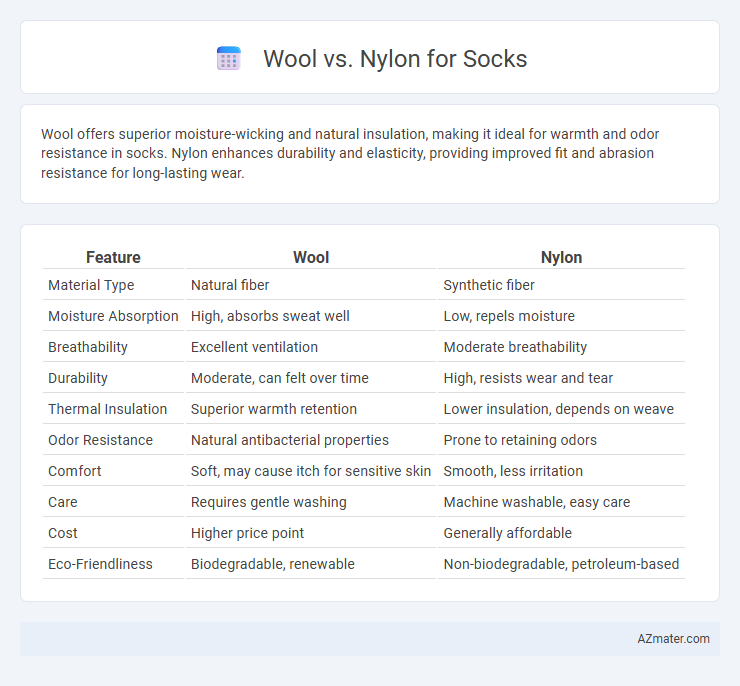Wool offers superior moisture-wicking and natural insulation, making it ideal for warmth and odor resistance in socks. Nylon enhances durability and elasticity, providing improved fit and abrasion resistance for long-lasting wear.
Table of Comparison
| Feature | Wool | Nylon |
|---|---|---|
| Material Type | Natural fiber | Synthetic fiber |
| Moisture Absorption | High, absorbs sweat well | Low, repels moisture |
| Breathability | Excellent ventilation | Moderate breathability |
| Durability | Moderate, can felt over time | High, resists wear and tear |
| Thermal Insulation | Superior warmth retention | Lower insulation, depends on weave |
| Odor Resistance | Natural antibacterial properties | Prone to retaining odors |
| Comfort | Soft, may cause itch for sensitive skin | Smooth, less irritation |
| Care | Requires gentle washing | Machine washable, easy care |
| Cost | Higher price point | Generally affordable |
| Eco-Friendliness | Biodegradable, renewable | Non-biodegradable, petroleum-based |
Introduction: Choosing the Right Sock Material
Wool offers superior moisture-wicking and natural insulation, making it ideal for temperature regulation in socks, especially in cold or wet conditions. Nylon enhances sock durability and elasticity, providing a snug fit and increased resistance to wear and tear. Combining wool with nylon often results in socks that balance comfort, warmth, and longevity for diverse activities.
Key Differences Between Wool and Nylon Socks
Wool socks excel in moisture-wicking, insulation, and natural odor resistance, making them ideal for cold, damp conditions. Nylon socks offer superior durability, elasticity, and quick-drying properties, often used in athletic or high-wear environments. The key differences lie in wool's breathability and warmth versus nylon's strength and abrasion resistance.
Comfort and Feel: Wool vs Nylon
Wool socks provide superior moisture-wicking and natural temperature regulation, resulting in a warm, breathable, and comfortable feel ideal for both cold and moderate climates. Nylon socks offer a smooth, lightweight texture with enhanced durability and stretch but may lack the softness and thermoregulation properties of wool. For all-day comfort, wool excels in cushioning and odor resistance, while nylon prioritizes fit and abrasion resistance.
Moisture Management and Breathability
Wool fibers naturally wick moisture away from the skin, maintaining dryness and providing excellent breathability, making them ideal for socks used in cold or damp conditions. Nylon, being a synthetic material, offers durability and quick-drying properties but lacks the same moisture-regulating capabilities as wool. Combining wool with nylon in sock blends often results in enhanced moisture management and improved breathability, balancing comfort and performance.
Durability and Longevity Comparison
Wool socks offer exceptional durability due to their natural elasticity and resilience, allowing them to maintain shape and resist wear over time. Nylon, often blended with wool, significantly enhances sock longevity by adding strength and abrasion resistance, preventing holes and thinning in high-friction areas. Combining wool and nylon creates a durable sock that balances moisture-wicking properties with long-lasting performance suitable for both everyday use and outdoor activities.
Thermal Regulation and Insulation
Wool excels in thermal regulation and insulation due to its natural crimp, trapping air to retain warmth while allowing moisture to evaporate, which keeps feet dry and comfortable. Nylon, a synthetic fiber, offers durability and moisture-wicking properties but lacks the breathability and superior insulating abilities of wool. Combining wool with nylon in socks enhances thermal insulation while improving strength and moisture management for optimal foot temperature control.
Odor Resistance: Which Is Better?
Wool excels at odor resistance due to its natural antimicrobial properties that inhibit bacterial growth, making it ideal for socks worn during extended activities. Nylon, while offering durability and moisture-wicking capabilities, tends to retain odors more readily because it lacks inherent antibacterial qualities. Choosing wool socks provides superior odor control for active lifestyles and long-duration wear.
Eco-Friendliness and Sustainability
Wool socks offer superior eco-friendliness due to their natural, biodegradable fibers sourced from renewable sheep wool, which requires less energy and chemicals in production compared to synthetic materials. Nylon socks, while durable and lightweight, are derived from petroleum-based polymers that contribute to fossil fuel depletion and generate microplastic pollution during washing. Choosing wool over nylon supports sustainable practices by minimizing environmental impact through renewable resources and reducing plastic waste in ecosystems.
Cost and Value Analysis
Wool socks generally cost more upfront than nylon socks due to the natural fiber's superior insulation, moisture-wicking, and odor-resistant properties, which enhance comfort and durability. Nylon socks offer a lower price point and increased durability but lack the breathability and temperature regulation of wool, potentially reducing their overall value for long-term use. Evaluating cost versus value, wool socks provide better performance and longevity for active or outdoor wearers despite higher initial investment, while nylon socks suit budget-conscious consumers seeking basic durability.
Best Uses: When to Choose Wool or Nylon Socks
Wool socks excel in moisture-wicking and insulation, making them ideal for cold weather activities like hiking, skiing, or everyday winter wear where warmth and odor resistance are crucial. Nylon socks are durable, lightweight, and quick-drying, suited for high-intensity sports, running, or casual wear in warmer climates where breathability and abrasion resistance are priorities. Choosing wool provides natural temperature regulation and cushioning, while nylon offers enhanced durability and stretch, perfect for long-lasting performance and fit.

Infographic: Wool vs Nylon for Sock
 azmater.com
azmater.com